
“Re-Modernologio” phase2 :Observation and Notation
October 23 (Sun) ~ December 18 (Sun), 2011 10:00 - 18:00 / Free
TOMII Motohiro

fonud composition
Found Composition - Sculpting Based on Instantaneous Observation
HATTORI Hiroyuki
“What kind of structure should I select in order to let things exist both as they are and also as unique objects? The inherent conditions of each thing, e.g. size, material, weight, shape, and fixed images, determine the shape of a thing. The determined shape finds a new use for the thing, which is the most appropriate for itself. The newly adopted use is unique to the thing with this particular structure. From the moment of adoption, it is not a use anymore, it becomes a new condition of the thing. This quality is simultaneously restraint and potential. Autonomy can be achieved only from restraint.”[i]
This is an excerpt from Motohiro Tomii's statement. Tomii makes sculptures by combining everyday things around us. He first tries to discover "things / materials" that seem to have potential to form a work, and observes them with time and care to discover their inherent natures and characteristics. He then subjects them to simple actions, such as lining, accumulating, binding, folding, etc. As his statement suggests, the method Tomii employs to make his sculptures can be described as "finding a new use for the thing, which is the most appropriate for itself."
Let me give some examples. The work "goldfinger" consists only of mass-produced golden-colored thumbtacks, a common tool to pin things like paper on the wall. Focusing on the "function / nature" of thumbtacks, which is "sticking into a wall," Tomii makes the rectangular shape solely by the act of sticking tens of thousands of them into a wall, in a grid-like pattern without interspaces. Without applying artistic modification to the thumbtacks, he just repeats the act of "sticking," and presents the resultant volume as a sculptural work. This work is applaudable as a "layout" to display the shape, color, and function of thumbtacks quite effectively, but what is radical here is the way Tomii presents this as a "sculpture." The beauty of the work is overwhelming just like sublime paintings, but at the same time, they still appear as nothing but thumbtacks.
The work "woods #2" consists of an ordered placement, forming three lines on the floor, of hammers with various handle lengths, each standing with its head down. This is based on the nature of the structure of a hammer: the metal head is heavier than the wooden handle, therefore it stands stably with its head down. In order to show this fact literally, the hammers are placed upside down in a systematic manner. From any angle, they still remain as nothing but hammers, but in fact, they have been deprived of their function as a tool. By being put next to each other in rows, their "forms" and "structures" are foregrounded. In other words, they have been transformed into a three-dimensional artwork with an interesting and beautiful design worthy of being viewed.
Tomii takes a long time to observe an object carefully to discover the cause-effect relationship, so to speak, behind its existent color and shape. It can be said that he makes sculptures in order to show this discovery. His keen eye and monomaniacal attitude, for thorough exploration of the structures of everyday things, remind us of KON Wajiro's observational eye, and his skill of discovery towards our customs and lifestyles.
In his project at ACAC, the artist’s focus has been placed on improvisational and instantaneous, rather than careful and long-term, methods of observation, as well as exploring ways to present and describe what he has discovered in that process. This is an approach quite opposed to his usual style of making. If his usual works can be compared to tableaus completed after a long-term process of trial and error, the works this time are like experimental, one-time only drawings or sketches. Usually, Tomii first takes a long time to observe a certain material to perfectly grasp its characteristic, and then derives the most effective way to show the structure. In contrast, in his attempt this time, the artist's emphasis has been on the act of finding out, in a given situation, attractive relationships (compositions) of things, and crystalizing such discoveries as his work.
Concretely speaking, he first takes a look at every detail of all parts of the premises of ACAC, including its back yard and the shared studios, where various things are randomly placed. He then picks up attractive and beautiful arrangements and combinations among them, makes adjustment to emphasize their accents, and finally relocates them to the gallery, bringing into relief the charm that those "existing compositions" originally had. Scattered in the gallery are about 30 supposed-to-be artworks seemingly unrelated to each other, such as an office chair with a rolled paper put on its seat, a cardboard box on which a red sled is put upside down, two brooms leaning against the wall, one in the normal way and the other upside down, and so on. They make you wonder, "Are these really artworks?" But if you pay attention carefully enough to each detail, you will recognize various facts. Though apparently placed without consideration, these objects are highlighted by spotlights. Moreover, each work is titled, which can be seen on the caption next to them, such as "found composition 2011100906 broom and upside-down broom" for the two brooms. Over all, you sense a feeling of tension due to the extremely careful arrangement of the objects. For example, there is a hidden order based on spatial segmentations of the gallery, such as the joint layout of the floor. Also, the interrelation of things featured in each work itself is quite delicate, such as the three transparent acrylic display boxes on top of each other in exact center alignment for "found composition 2011092309 aligned centers (transparent)," two poles, standing in an uneasy balance, tied together at the top with a rope "found composition 2011092312 2 poles tied together" , and so on. In such a manner, Tomii chooses certain kinds of balanced interrelations and structures of objects, and refines them with minimal additional actions. Resultant improvisational "compositions" are arranged in a comfortable rhythm in the round corridor-shaped gallery space.
The series titled "today's sculpture" shows acceleration of his improvisation activities. This is a daily practice of documenting "found compositions" to train his skill for discovering hidden structures (his eye of observation). For a long time, the artist has actually continued to photograph objects that he encounters and in which he finds intriguing arrangements or interrelations, as if taking brief notes of daily discoveries, as a means to collect resources and gain inspiration for his sculptures. Due to their nature, it is unlikely that such photographs would be shown to the public. However, this time, he decided to publicize this practice by posting one photo on twitter everyday, under the title of "today's sculpture." Simultaneous to twitter, the same photo is shown on a monitor at the exhibition site, as a sculpture being updated everyday. Twitter is the ultimate site of improvisation and note taking, where pieces of information continue to flow past at all times on each user's timeline. Showing his daily discovery real-time on this seems to veer away from his past stance. However, it makes a great deal of sense to do this in this exhibition, where he chose to adopt an artistic process opposite to that of his usual practice. The series of "found composition" reflects Tomii's keen eye of discovery and skill of observation in a more vivid and purified way. Although this improvisational approach may appear to be "loose," there is potential that this will lead to further developments in the future. Generally speaking, an artist-in-residence program is designed to serve as a platform for artists to try new or experimental approaches through the long-term stay, making works that are unrealizable in a usual studio practice or normal exhibitions, where it is expected to show completed or established works. In this sense, it can be said that Tomii's challenge was an achievement made possible due to such an environment at ACAC.
Also, another important factor is that this time he chose to show sheets of "instruction paper" that indicate how to compose the described work. Most of his sculptures consist of multiple objects, and they can be decomposed into each object, because no irreversible actions, such as gluing, are employed when making. For example, "four color sponges" is formed with four kinds of kitchen sponges each of a different, single color, piled up according to a set of certain rules, and "ball pipe ball" features a structure made of scaffolding pipes with baseball balls inserted at their nodes as supports. Because, as described above, each of these structures can revert back into the original units when the exhibition is over, the "instruction paper" has as much importance as the work itself. Nevertheless, such paper is usually hidden, because sculptural objects are more than adequate as exhibits. However, it was very important this time, as his exhibits were not objects, but "compositions" he had found and refined. Each paper is very eloquent about exactly what he saw value in when he encountered the found composition.
In fact, Tomii has exhibited his instructions once, in his solo show titled "How to Make the World," held at art & river bank, an alternative space in a suburb of Tokyo. In this exhibition, he experimented with a radical method of installation: putting on the wall, instruction paper sheets that indicated how to construct some of his past works, along with all parts of the instructed works wrapped and arranged on the floor. The installation at ACAC must have been his second attempt following that. It is an interesting fact that both challenges seem to have reflected the basic nature of the venues, the alternative space and the artist residency, where new challenges are encouraged in principle.
No matter what he shows, his practice has been always based on his exceptional skill of observation, through which he can grasp the essence of the object. Therefore, viewing the resultant sculptures also requires careful attention, through which we train ourselves to develop an "eye to discover" and "skill of multifaceted observation." In other words, through viewing his work, we may gain a knack of look into the world with a high-resolution eye, and to live everyday creatively. If the resolution of our eye was as high as, and our perspective as diverse as the artist, our life would be filled with more discoveries and inspirations.
As an aside, I have discovered and felt very excited regarding the similarity between the overall feeling of Tomii's instruction paper and that of KON Wajiro's drawings, due to the use of clear and soft lines to represent things and rounded letters to describe details. It is perhaps that by spending time with Tomii’s work, the resolution of my observational eye has improved a little bit.
[i] *Excerpt from "The Reason to Make," statement of the artist on his website: http://tomiimotohiro.com/statemente.html
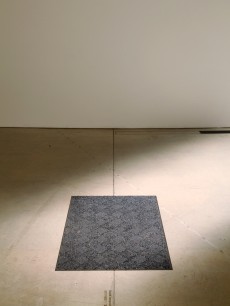
found composition 2011100211 entrains rug

found composition 2011100903 more than 4 boxes
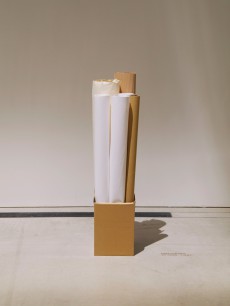
found composition 201110209 tube and box
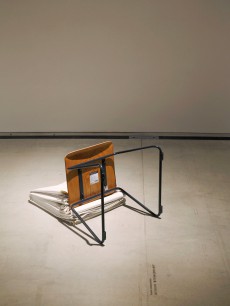
found composition 2011092308 overly heavy fabric and fallen chair
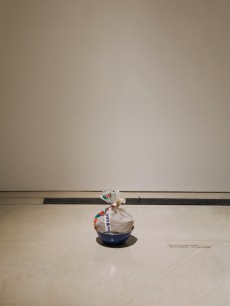
found composition 2011100204 bowl and sandbag
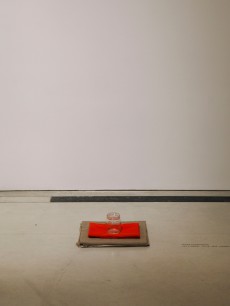
found composition 2011100901 aligned centers (Elegant combination)
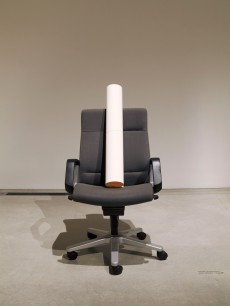
found composition 201100904 chair and tube
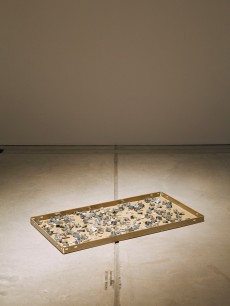
found composition 2011100904 encrusted
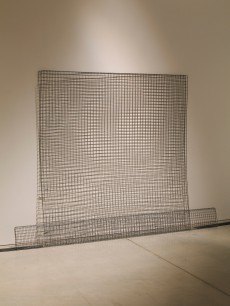
found composition 2011100202 4 wire netting
「再考現学 / Re-Modernologio」phase2 : 観察術と記譜法
2011年10月23日(日)~12月18日(日) 10:00 - 18:00/無料
冨井大裕
TOMII Motohiro

《fonud composition》
found composition ~瞬発的観察術による彫刻法
服部浩之
「ものをそのままでありながら異なるものとして立ち上げるためには、どのような構造を選べばよいか。ものが与える条件(サイズ、素材、重さ、形、ものが常識的にまとっているイメージなど)から構造は選択される。選ばれた構造は、自身に最適なものの新しい使用法を見つけ出す。新しい使用法は、そのものとその構造のため以外には採用されない。そして、採用されたその時から、使用法は使用法ではない、ものの新たな条件となる。条件とは不自由であり、可能性である。不自由からしか自由は得ることが出来ない。」[i]
上記は冨井大裕のステイトメントの一部分を抜粋したものだ。冨井は身の回りにあるものを組合せることで彫刻作品をつくる。ステイトメントにあるように、作品として成立し得る「もの/素材」を発見し、丁寧に時間をかけてそれをよく観察することで、その物体が備えている性質や特徴を見出し、並べる/重ねる/束ねる/折り曲げるなどのささやかな行為を加えることで、「最適なものの新しい使用法を見つけ出す」ように彫刻化する。
その作品例を挙げると、紙などを留める金色の画鋲のみを大量に用いた《ゴールドフィンガー》は、画鋲の「刺して留める」という「機能/性質」に着目し、それを一定のグリッド上に長方形になるように何万個も密着させてただひたすら壁に打ち込んでいくことで成立させた作品だ。冨井は画鋲を加工することなく「刺す」行為のみを反復し、その刺した量塊をもって彫刻作品とするのだ。これは画鋲の備えるかたちや色や機能を最も効果的に見せる陳列法(レイアウト)として非常に見事だが、それをもって彫刻作品とするところに冨井の尖鋭的な魅力がある。その作品は荘厳な絵画のような圧倒的な美しさを備えているが、それと同時にどう見ても画鋲そのものでしかないことも事実だ。
また、柄の長さが異なる2種類のハンマーを、ヘッド部分を下にして三列に規則的に反復させ並べた立体作品《woods #2》は、木製の柄の部分より金属のヘッド部分の方が重くヘッドを下にすると自立するというハンマーの機能から導き出された構造的特性を発見し、それを見せるように上下逆さに整然と陳列するものだ。どこからどう見てもハンマーなのだが、その道具としての機能を剥奪し連続的に陳列することで、「かたち」や「構造」に焦点を当て、そのかたちの面白さや美しさを引き出し眺めるべき立体作品に変換してしまうのだ。
このように冨井は、「もの」自体を長い時間をかけて非常に丁寧に観察し、そのかたちや色が成立する因果関係を発見し、それを見せるために彫刻作品として提示しているようにさえ思われるのだ。徹底的に構造的な視点で身の回りのものを追求するマニアックな眼には、今和次郎の生活や風俗を捉える観察の眼と発見の術が想起される。
ACACでは、極めて即興的で瞬発的な観察による発見とそれを記述する方法に特化し、上記した通常のつくり方とまるで逆のアプローチをとった。通常の作品が長い時間をかけて試行錯誤の末に完成されるタブローなら、今回の作品はどちらかというと実験的で一回性の高いドローイングやスケッチのようなものだ。これまでのように特定の素材を長い時間をかけて観察しその特徴を完全に把握した上で、そのものを見せる効果的な構造を導き出し作品化するのではなく、既にあるものとものの魅力的な関係=構成を発見することに主眼を置き、その発見そのものを作品として定着することを試みた。
具体的にはACAC敷地内を隈無く眺め、バックヤードや制作スタジオなどのものが雑然と置かれた状況に、配置や関係の美を発見し、そこから抽出したものをそのままギャラリー空間に持ち込み、整理整頓により特徴や関係をデフォルメし純化することで「既存の構成」の妙を見せるに至ったのだ。ギャラリーには、OAチェアの上に丸めた紙筒がポツンと置かれていたり、小さなダンボール箱の上に赤いそりが逆さに乗せられていたり、あるいは二本のほうきが一本はそのままでもう一本は上下逆さまで隣り合わせで並べられていたりと、なんの脈絡もなさそうな計30点の作品らしきものがぽつぽつと配置されている。「これが作品なのか?」と訝しみつつも少し注意して会場を眺めてみると、様々なことに気付く。無造作に置かれたように見える物質群には、それぞれスポット照明が当てられており、例えば二本のほうきの右手には《found composition 2011100906 “ほうきときうほ”》とタイトルが記されており、ほかの全ての作品の脇にも同様に各タイトルが付されている。その上で全体を俯瞰して見ると、床の目地割りなどの空間の手がかりに沿って秩序立てて緊張感さえ漂うように細心の注意のもと作品が配置されていることが看取される。また作品一点一点も非常に繊細な関係で成立しているのだ。寸分違わずセンター合わせで3段に重ねられた透明なアクリルボックスによる《found composition 2011092309 “センター合わせ(透明)”》、上部をロープで縛られて2本のポールが精妙な均衡で立つ《found composition 2011092312 “つながれた2本のポール”》など、ものの関係や構造を絶妙なバランスで切り取りほんの少し整理することで洗練させた即興的な「構成=composition」が、回遊的な空間に心地よいリズムで配置されているのだ。
この即興性をさらに加速させるのが《今日の彫刻》という作品だ。これはまさに発見の眼(観察眼)を鍛えるトレーニングのように、日々《found composition》を実践するものだ。冨井は気になるものの配置や関係を発見してはメモ的に写真に収めるという行為を長年続けており、それは普段の作品のリソースを蓄積するようなもので、これまでならおそらく決して人前には出さない類のアイディアの源だ。それらの写真から一日一点だけ選んで、《今日の彫刻》と題して毎日twitter上で公開することを決め、それと同じ画像を展示室でもモニター上で毎日更新される彫刻として公開していた。タイムラインが常に流れ去っていくtwitterこそ即興とメモの極みで、そこで日々の発見を刹那的に公開していくことは、これまでの冨井のスタンスからはかなり逸脱している。ただ、通常の彼の作品とは手順がまるで逆の《found composition》は、冨井の鋭い発見の眼と観察の手法がより純化されたかたちで提示されたものであると言ってよいだろう。一見「ゆるい」と思われるこの即興的な取り組みからは、今後の新たな展開も期待されるであろう。アーティスト・イン・レジデンスとは、完成され確立された作品を見せる場というより、通常の制作環境や展覧会では実現しづらい新しい試みや実験を滞在制作により存分に行う場であるので、今回の冨井の挑戦はこの環境だからこそ生まれた成果でもあるのだ。
また、今回の試みにおいてもうひとつ重要なことは、作品の成立法を示す「指示書」を展示物として公開したことだ。冨井はその彫刻の素材に接着などの加工を施すことはなく、元来の「もの」に戻すことが可能な「組合せ」のみで成立させることがほとんどだ。例えば《four color sponges》は4色の台所用スポンジをある規則のもと積み重ねるのみのものだし、《ball pipe ball》は単管パイプの結節点に野球ボールを挿入し、構造体を組上げたものだ。展示が終了したらもとの素材の単位に戻すことができるものばかりなので、その構成や配置の仕方を詳細に記した「指示書」が実は作品として公開されるものと同じくらい重要なのだ。通常はものそのものを見せるので指示書の公開は必要ないが、今回は発見し整理整頓して抽出した「構成」を作品としているので、その手法を記す「指示書」の公開が重要なのだ。指示書からは冨井が如何にそのcompositionに価値を見出したかが具体的に読み取ることができる。
ちなみに、これまでもart & river bankというオルタナティブスペースでの「世界のつくりかた」という個展において、過去に制作した作品を組み立てる手順を記した指示書を壁に設置し、床にはそれらの作品の素材を梱包した状態で置くのみという非常にラディカルで実験的なことを試みているが、指示書を展示したのはそれ以来だろう。奇しくもオルタナティブスペースとアーティスト・イン・レジデンスというどちらも公然と新たな挑戦が奨励されている場での転換を図るような実践というのが興味深い。
いずれにしても、冨井の作品はものをよく見てその性質を鮮やかに見抜くという非常に高い観察の技術に支えられている。そして、それを彫刻として提示される私たち鑑賞者も、注意深くその作品を鑑賞することで、「発見する眼」や「ものごとを多面的に捉える観察力」が鍛えられるのだ。作品鑑賞を通じて私たちは日々の世界を精細な眼で捉え日常生活を創造的に営むヒントを獲得する。冨井のように非常に解像度の高い眼で身の回りに溢れるものを複数の方向から眺める方法を手にすることができるなら、ささやかな日々にも無数の気付きがあり日常生活が少しだけ刺激に富んだものになるかもしれない。
余談になるが、はっきりした柔らかな単線の描画と丸めの文字による詳細な記述という今和次郎のドローイングの特徴と類似する質や表現法を冨井大裕の指示書にも発見し、そこに不思議な接点を見出しひとりで心が躍ったりした。冨井作品と対峙することで、少しだけ観察する眼の解像度が向上したのかもしれない。
[i] 冨井大裕ウェブサイト、ステイトメント「つくることの理由」よりhttp://tomiimotohiro.com/statementj.html

《found composition 2011100211 “足ふきマット”》

《found composition 2011100903 “4つ以上の箱”》

《found composition 201110209 ”つつとはこ”》

《found composition 2011092308 “重過ぎる布と倒れた椅子”》

《found composition 2011100204 “ボウルと砂袋”》

《found composition 2011100901 “センター合せ(上品な組み合わせ)”》

《found composition 2011092311 "イスと筒”》

《found composition 2011100904 “散りばめる”》

《found composition 2011100202 “4枚の金網”》
